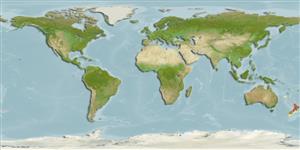Elasmobranchii (hajar och rockor) (sharks and rays) >
Myliobatiformes (Stingrays) >
Myliobatidae (Eagle and manta rays)
Etymology: Myliobatis: Greek, mylo = mill + Greek, + Greek, batis,-idos = a ray (Raja sp.) (Ref. 45335).
Environment: milieu / climate zone / depth range / distribution range
Ekologi
marina; brackvatten bentopelagisk; djupintervall 0 - 160 m (Ref. 26346). Temperate
Southwest Pacific: Norfolk Island and New Zealand, including the Kermadec Islands.
Size / Vikt / Age
Maturity: Lm ? range ? - ? cm
Max length : 150 cm WD hane/ej könsbestämd; (Ref. 12951); common length : 100.0 cm TL hane/ej könsbestämd; (Ref. 9258)
Short description
Bestämningsnycklar | Morfologi | Morfometri
Olive-green, yellow or dark brown dorsally with pale blue or grey markings; white ventrally (Ref. 26346). No caudal fin (Ref. 26346).
Occurs in bays, estuaries, and near rocky reefs (Ref. 12951). Usually solitary (Ref. 12951). Feeds on clams, oysters, worms, and crabs (Ref. 12951). Ovoviviparous (Ref. 50449). Although the spine on the tail is capable of inflicting a painful wound, the poison is quickly neutralized by immersion of the injured area in hot water (Ref. 26346).
Life cycle and mating behavior
Könsmognad | Reproduktion | Lek | Ägg | Fecundity | Larver
Exhibit ovoviparity (aplacental viviparity), with embryos feeding initially on yolk, then receiving additional nourishment from the mother by indirect absorption of uterine fluid enriched with mucus, fat or protein through specialised structures (Ref. 50449). Young are born at less than 50 cm (Ref. 26346).
Francis, M.P., 1993. Checklist of the coastal fishes of Lord Howe, Norfolk, and Kermadec Islands, Southwest Pacific Ocean. Pac. Sci. 47(2):136-170. (Ref. 8879)
IUCN Red List Status (Ref. 130435: Version 2024-1)
Human uses
Fiskeri: mindre kommeriell
Verktyg
Special reports
Download XML
Internet-källor
Estimates based on models
Preferred temperature (Ref.
123201): 14.4 - 19.8, mean 16.6 °C (based on 74 cells).
Phylogenetic diversity index (Ref.
82804): PD
50 = 0.5002 [Uniqueness, from 0.5 = low to 2.0 = high].
Bayesian length-weight: a=0.00389 (0.00119 - 0.01269), b=3.08 (2.83 - 3.33), in cm total length, based on LWR estimates for this (Sub)family-body shape (Ref.
93245).
Trofisk nivå (Ref.
69278): 3.5 ±0.4 se; based on size and trophs of closest relatives
Resiliens (Ref.
120179): Låg, lägsta populationsfördubblingstid 4,5-14 år (Fec assumed to be <100).
Fishing Vulnerability (Ref.
59153): Very high vulnerability (83 of 100).
Nutrients (Ref.
124155): Calcium = 3.64 [0.51, 61.12] mg/100g; Iron = 0.186 [0.018, 2.244] mg/100g; Protein = 19.8 [14.5, 25.0] %; Omega3 = 0.327 [0.095, 0.951] g/100g; Selenium = 14.3 [2.7, 79.6] μg/100g; VitaminA = 4.82 [0.41, 52.01] μg/100g; Zinc = 0.407 [0.030, 4.511] mg/100g (wet weight);
